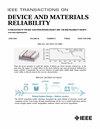镀金属铝表面银烧结键合的热冲击可靠性
IF 2.3
3区 工程技术
Q2 ENGINEERING, ELECTRICAL & ELECTRONIC
IEEE Transactions on Device and Materials Reliability
Pub Date : 2025-03-24
DOI:10.1109/TDMR.2025.3554369
引用次数: 0
摘要
银(Ag)烧结对未来宽带隙(WBG)功率模块衬底的连接变得越来越重要。然而,目前,镀铝(Al)散热器和直接粘合铝(DBA)衬底的烧结银接头可靠性较差。为了解决这一问题,本文研究了烧结银接头铝表面镀镍/银金属化的可靠性,并提出了一种新的镀镍/铜/银金属化堆栈,以提高可靠性。研究了不同金属化层的烧结银接头的抗剪强度和热冲击可靠性,并对其破坏模式进行了金相组织和元素分析。结果表明,传统的Ni/Ag金属化烧结的Ag接头由于Ni与Ag之间的附着力差,可靠性受到很大限制。相比之下,新型Ni/Cu/Ag金属化烧结Ag接头的抗剪强度在500 TS循环中始终保持在40 MPa以上,其主要破坏模式为Al/Ni分层和内聚破坏。烧结时间较长的Ni/Cu/Ag金属化制备的烧结Ag接头消除了不必要的分层破坏模式,只留下了首选的内聚破坏模式;抗剪强度显著提高,达到130 MPa。此外,在Ni/Cu/Ag堆的烧结Ag接头中出现了一种新的失效模式,表明Al/Ni金属化缺陷的限制因素较小。这证明了我们的新型金属化堆叠解决了目前使用Al散热器和DBA衬底的银烧结接头中的分层问题,从而支持开发烧结银接头的全部潜力。本文章由计算机程序翻译,如有差异,请以英文原文为准。
Thermal Shock Reliability of Silver-Sintered Bonding of Metal-Plated Aluminum Surfaces
Silver (Ag) sintering is becoming more critical for future wide bandgap (WBG) power module substrate attachments. However, sintered Ag joints with plated aluminum (Al) heatsinks and directly bonded aluminum (DBA) substrates presently suffer from poor reliability. To resolve this problem, this work studies the reliability of plated (Nickel) Ni/Ag metallization on Al for sintered Ag joints and proposes a new plated Ni/Copper (Cu)/Ag metallization stack for improved reliability. The shear strength and thermal shock (TS) reliability of the sintered Ag joints for different metallization layers are studied, and microstructural and elemental analyses were performed to analyze the failure modes. The results show that the reliability of the sintered Ag joints by the traditional Ni/Ag metallization is rather limited because of poor adhesion between Ni and Ag. In contrast, the shear strength of the new Ni/Cu/Ag metallized sintered Ag joints is consistently above 40 MPa up to 500 TS cycles, with the dominant failure modes formed by Al/Ni delamination and cohesive failure. Preparing sintered Ag joints with the Ni/Cu/Ag metallization with longer sintering times removed the unwanted delamination failure mode and only left the preferred cohesive failure mode; moreover, the shear strength improved significantly, with values reaching 130 MPa. Furthermore, a new failure mode appears in the sintered Ag joint of the Ni/Cu/Ag stack, implying that the Al/Ni metallization weakness there is less of a limiting factor. This proves that our new metallization stack resolves present delamination issues in Ag sintered joints with Al heatsinks and DBA substrates and thereby supports exploiting the full potential of sintered Ag joints.
求助全文
通过发布文献求助,成功后即可免费获取论文全文。
去求助
来源期刊

IEEE Transactions on Device and Materials Reliability
工程技术-工程:电子与电气
CiteScore
4.80
自引率
5.00%
发文量
71
审稿时长
6-12 weeks
期刊介绍:
The scope of the publication includes, but is not limited to Reliability of: Devices, Materials, Processes, Interfaces, Integrated Microsystems (including MEMS & Sensors), Transistors, Technology (CMOS, BiCMOS, etc.), Integrated Circuits (IC, SSI, MSI, LSI, ULSI, ELSI, etc.), Thin Film Transistor Applications. The measurement and understanding of the reliability of such entities at each phase, from the concept stage through research and development and into manufacturing scale-up, provides the overall database on the reliability of the devices, materials, processes, package and other necessities for the successful introduction of a product to market. This reliability database is the foundation for a quality product, which meets customer expectation. A product so developed has high reliability. High quality will be achieved because product weaknesses will have been found (root cause analysis) and designed out of the final product. This process of ever increasing reliability and quality will result in a superior product. In the end, reliability and quality are not one thing; but in a sense everything, which can be or has to be done to guarantee that the product successfully performs in the field under customer conditions. Our goal is to capture these advances. An additional objective is to focus cross fertilized communication in the state of the art of reliability of electronic materials and devices and provide fundamental understanding of basic phenomena that affect reliability. In addition, the publication is a forum for interdisciplinary studies on reliability. An overall goal is to provide leading edge/state of the art information, which is critically relevant to the creation of reliable products.
 求助内容:
求助内容: 应助结果提醒方式:
应助结果提醒方式:


